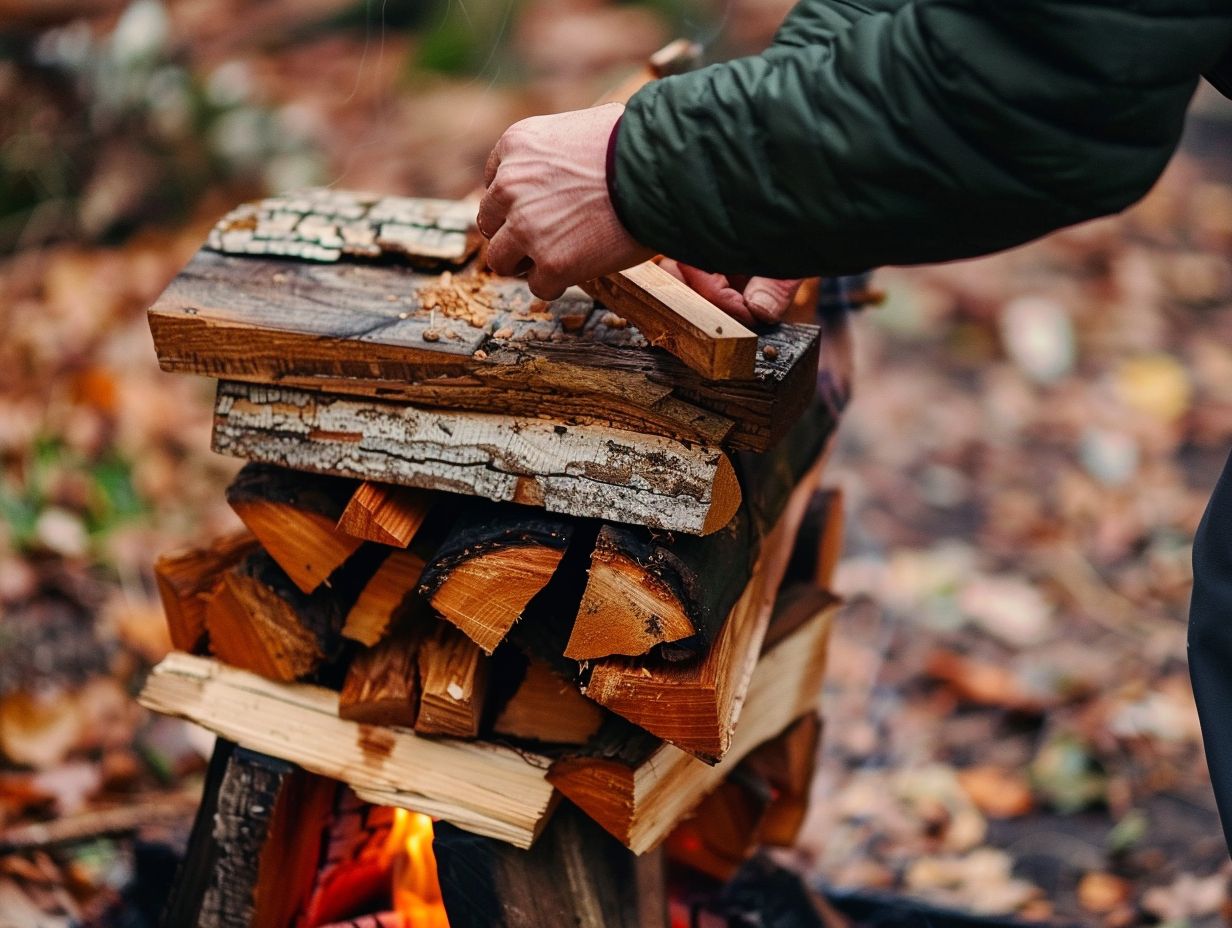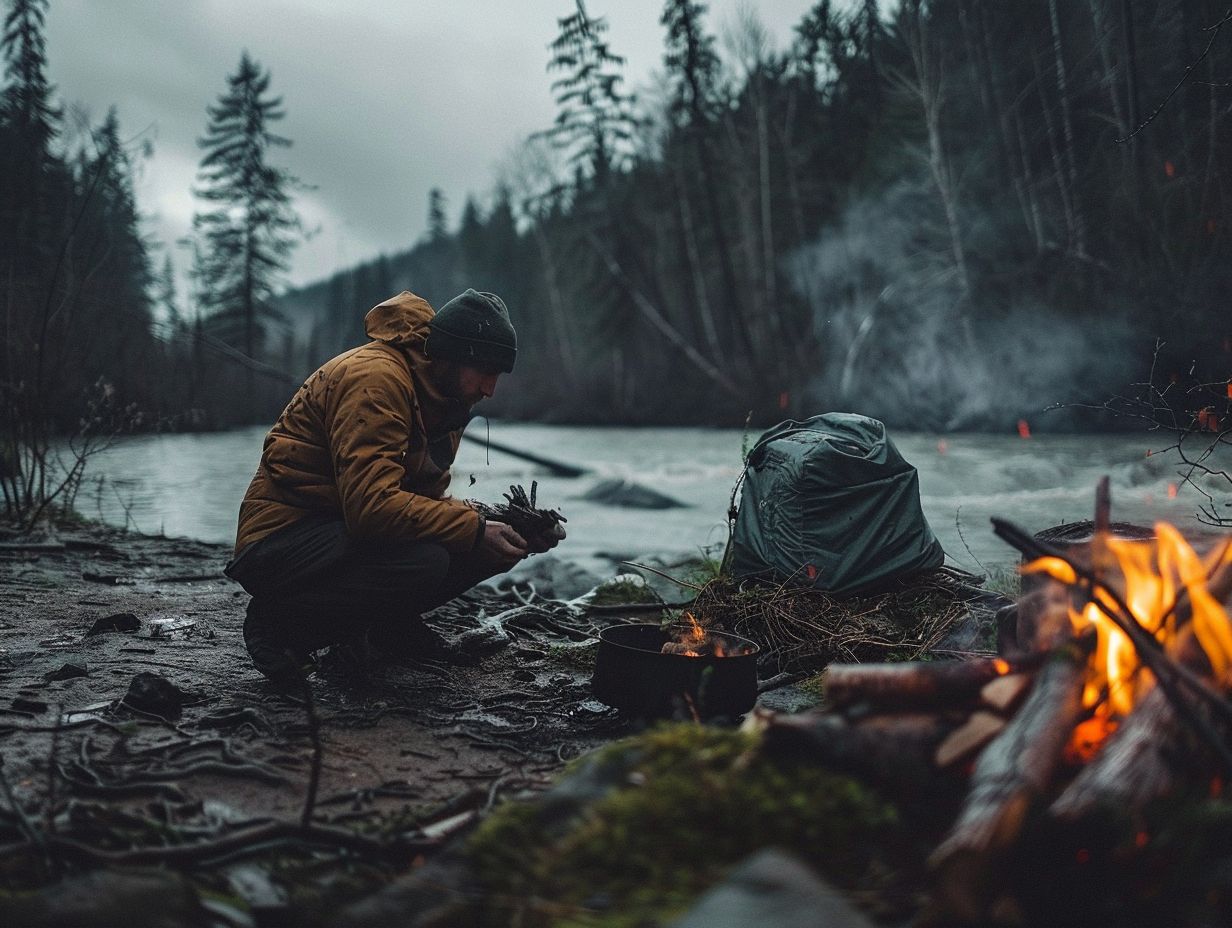Campfires are a beloved tradition of camping, but they can have a significant impact on the environment if not done responsibly.
In this article, you will explore the importance of sustainable campfires and how to choose the right location for a fire.
You will also learn about gathering and preparing materials, building and maintaining the fire, and proper techniques for extinguishing and cleaning up afterward.
Additionally, alternative methods for cooking and heating will be discussed, providing you with a comprehensive guide for a sustainable camping experience.
Key Takeaways:

- Consider the environmental impact and practice responsible camping when building a campfire.
- Assess fire safety and potential hazards before choosing a location for your campfire.
- Properly prepare and maintain your fire using sustainable materials and techniques, and properly extinguish and clean up afterwards to leave no trace.
The Importance of Sustainable Campfires
Sustainable campfires play a crucial role in outdoor activities, providing warmth, light, and a communal atmosphere.
Understanding the impact of campfires on the environment and practising responsible camping techniques is essential for preserving natural ecosystems and ensuring future generations can enjoy the beauty of the outdoors.
By utilising sustainable campfire building techniques, such as employing locally sourced firewood, controlling the size of the fire, and properly extinguishing it, you can reduce your environmental impact.
Following safety regulations, such as maintaining a safe distance from flammable materials and never leaving a fire unattended, is essential for preventing wildfires and safeguarding the surrounding wildlife.
Embracing responsible camping practices not only protects the environment but also cultivates a deeper connection with nature and encourages a culture of conservation among outdoor enthusiasts.
Gathering and Preparing Materials for a Campfire

Effective campfire preparation for you begins with gathering the right materials, such as kindling, tinder, and wood, to ensure a successful fire-building process. It is crucial that you understand the different types of fuel sources and igniting techniques for a safe and enjoyable campfire experience.
Kindling, which consists of small sticks or twigs, serves as the foundation of the fire and ignites easily. Tinder, such as dry leaves or shredded bark, catches fire quickly to ignite larger fuel. When selecting wood, it is recommended that you opt for a mix of sizes – from small branches for initial flames to larger logs for sustaining the fire.
Properly arranging these materials in a teepee or log cabin structure facilitates airflow and promotes efficient burning. Remember to adhere to fire safety protocols and local regulations to enjoy your campfire responsibly.
Proper Firewood Selection and Preparation
When selecting and preparing firewood for a campfire, it is crucial to ensure that the wood is suitable for sustaining a long-lasting and efficient fire.
It is recommended to choose high-quality firewood that has been seasoned for a minimum of six months to a year to reduce moisture content. Seasoned hardwoods like oak and maple are ideal as they burn longer and provide consistent heat, while softwoods like pine can be used for quick kindling.
Proper cutting techniques and arranging the firewood stack to allow adequate airflow are essential for promoting thorough combustion and minimising smoke output. By following these guidelines and storing your firewood correctly, you can improve your camping experience while also contributing to sustainable practices in outdoor recreation.
Building and Maintaining a Campfire
Building and maintaining a campfire requires your attention to detail and an understanding of fire dynamics. By following proper techniques, monitoring fuel sources, and ensuring adequate airflow, you can enjoy a safe and sustainable fire throughout your outdoor adventure.
An essential step is to clear the area around your fire pit, removing any flammable debris or overhanging branches. Once your site is prepared, gather different sizes of dry wood, from tinder to larger fuel logs, to build a well-structured fire.
When lighting your fire, use matches or a lighter with caution, ensuring that the flames are contained within the fire ring. As your fire burns, remember to never leave it unattended and keep a bucket of water nearby for emergencies.
Regularly feed your fire with small amounts of wood to maintain a steady burn and avoid sudden flare-ups.
Step-by-Step Guide to Building a Sustainable Fire
To create a sustainable campfire, you need to approach fire-building systematically, ensuring proper selection of wood, airflow, and extinguishing methods. Following a step-by-step guide will assist you in building a safe and environmentally friendly fire suitable for cooking, warmth, or social activities.
- Start by gathering three types of wood: tinder, kindling, and fuel wood. Tinder, such as dry leaves or paper, easily ignites and initiates the fire. Kindling, consisting of small twigs or sticks, aids in spreading the flame. Fuel wood, which comprises larger logs, sustains the fire.
- Arrange the wood in either a teepee or log cabin structure, beginning with the tinder at the centre. Remember to create a draught by leaving gaps for airflow.
- Prioritise safety by keeping a bucket of water and a shovel nearby at all times, and never leave the fire unattended. When extinguishing the fire, pour water over the embers and stir them until they have cooled down to the touch.
Extinguishing and Cleaning Up After a Campfire
Properly extinguishing a campfire and leaving no trace behind are essential practices for responsible campers. You should use water, a shovel, and adhere to local regulations for fire cleanup to ensure that the campsite remains pristine and safe for future visitors.
When you completely douse the fire with water and carefully stir the ashes to verify there is no remaining heat, you effectively mitigate the risk of potential wildfires.
Additionally, it is crucial to scatter the cold ashes over a wide area and remove any unburned debris such as food scraps or packaging. Not only does this practice aid in fire prevention, but it also contributes to maintaining the natural beauty of the environment.
By adhering to these fire safety principles, you showcase a dedication to environmental stewardship and guarantee the preservation of the wilderness for the benefit of future generations.
Proper Techniques for Putting Out a Fire and Leaving No Trace

To extinguish a campfire responsibly, you need to follow a series of safety precautions and demonstrate environmental awareness. Using water, a spade, and adhering to established protocols will help ensure the fire is thoroughly put out and the campsite is left undisturbed.
It is essential that you never leave a campfire unattended and have a bucket of water or a fire extinguisher readily available in case of emergencies.
When it is time to extinguish the fire, carefully pour water over the embers while simultaneously using a spade to stir the ashes, effectively cooling them. Repeat this process until all hissing sounds and smoke have stopped.
Afterwards, ensure to scatter the cooled ashes across a wide area and check there are no remaining hot spots. By using these methods, outdoor enthusiasts can enjoy responsible camping practices while safeguarding the natural beauty of the environment.
Alternative Methods for Cooking and Heating
Exploring alternative methods for cooking and heating in outdoor settings can offer you, as a camper, diverse options beyond the traditional campfires.
Utilising stoves, solar cookers, or portable grills provides you with efficient and environmentally friendly ways to prepare meals and stay warm while camping.
Stoves, such as compact backpacking stoves, are particularly convenient for quick meal preparations and boiling water. Solar cookers harness the power of the sun to slowly cook food, which is not only sustainable but also allows for a hands-off cooking experience.
Investing in insulated containers for storing hot beverages or food can help retain heat for longer periods, reducing the need for continual reheating.
These alternative methods not only offer you versatility but also promote eco-conscious practices in your outdoor recreational activities.
Using Stoves and Other Sustainable Options
Utilising stoves and other sustainable heating options can enhance your camping experience by providing you with reliable and controlled cooking environments. By following safety regulations and using efficient fuel sources, you can enjoy delicious meals and warmth without relying on traditional campfires.
Stoves offer the advantage of quicker cooking times and produce less waste compared to open fires. When selecting a stove, consider factors such as portability, ease of use, and compatibility with various fuel types.
Using portable stoves not only reduces environmental impact but also lowers the risk of wildfires. With advancements in technology, modern stoves are designed to be lightweight, compact, and eco-friendly, making them a convenient and sustainable choice for outdoor enthusiasts.
Frequently Asked Questions
What materials do I need to build a sustainable campfire?
To build a sustainable campfire, you will need small sticks and twigs, larger logs, fire starters, and a shovel or rake.
Why is it important to build a sustainable campfire?

Building a sustainable campfire reduces the impact on the environment and helps prevent wildfires.
How do I prepare the campfire site for sustainability?
Choose a designated fire pit or ring, clear away any debris or flammable material around the area, and create a base using rocks or a metal fire ring.
What is the best method for starting a sustainable campfire?
The best method is to use the top-down approach, where you place the larger logs on the bottom, followed by smaller logs, and then kindling on the top. This method allows for better airflow and reduces the need for constant maintenance.
How can I ensure my campfire is fully extinguished and sustainable?
Before leaving the campfire site, pour water over the fire until you can no longer hear any sizzling sounds. Then, use a shovel or rake to mix the ashes with soil to fully extinguish the fire.
What are some alternative ways to cook food on a sustainable campfire?
You can use a cast iron skillet or aluminum foil to cook food over the campfire. Additionally, you can bring a portable camp stove or grill that uses propane or charcoal for a more sustainable option.



